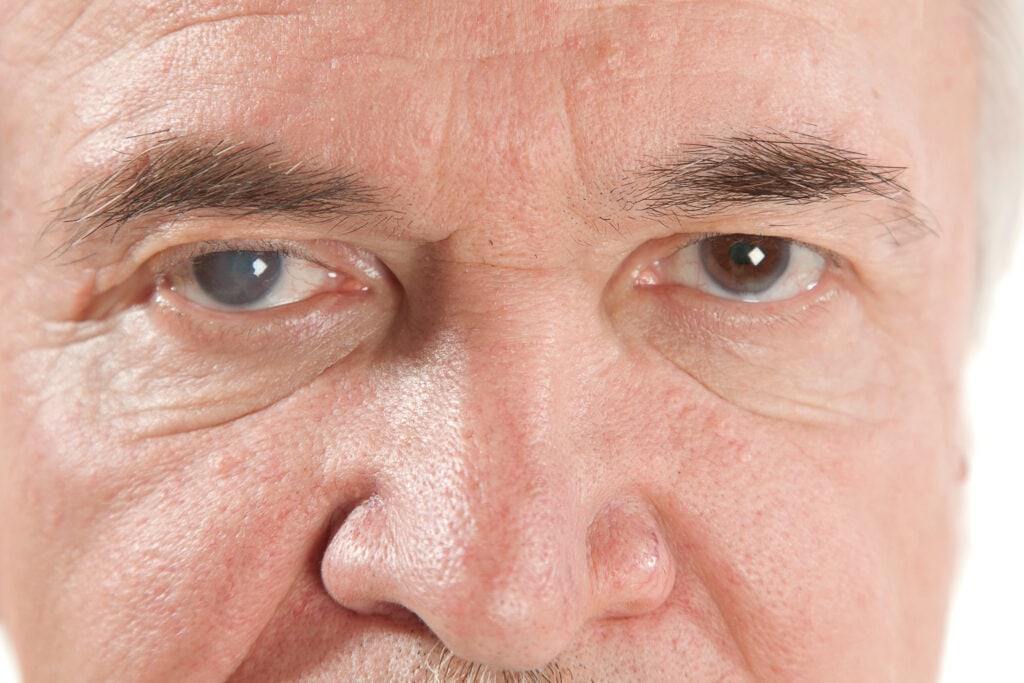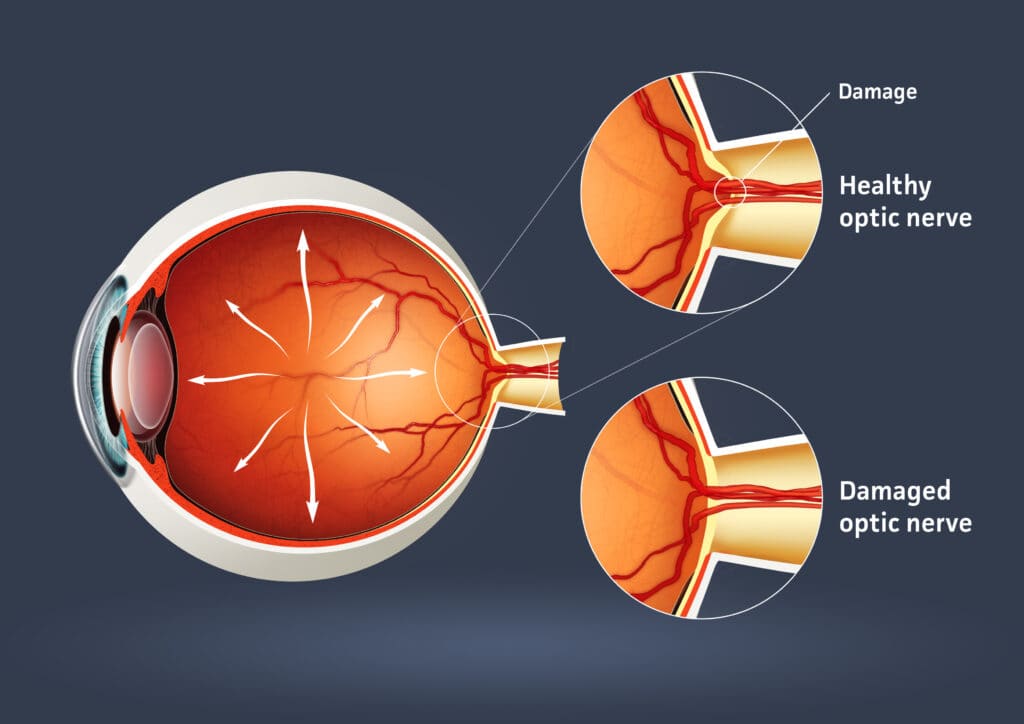Conditions
Glaucoma
Glaucoma is one of the leading causes of blindness in Canada as well as worldwide.
If undetected and left untreated, glaucoma can lead to irreversible damage to the optic nerve(s) and vision loss.
What is glaucoma?
Glaucoma is a progressive optic neuropathy, often but not always, caused by ocular hypertension (high eye pressure).
It’s important to note that glaucoma isn’t a single condition and is best described as a group of diseases that include the following non-exhaustive list:
- Primary open-angle glaucoma
- Angle-closure glaucoma
- Secondary glaucoma
- Normal-tension glaucoma
- Childhood glaucoma
Read on to learn more about the most common types of glaucoma, how your ophthalmologist can diagnose it, and what therapeutic options are available for treatment.
Primary open-angle glaucoma
Primary open-angle glaucoma is one the most common types of glaucoma, which manifests with high intraocular pressure (IOP), optic nerve damage, and visual field loss.
High pressure is thought to be caused by a decrease in flow through the canals in the angle between the cornea and iris. Despite the angle between these structures being open, the canal itself is dysfunctional, and pressure in the eye is high.
Early detection is crucial as optic nerve damage is irreversible. The earlier we can catch glaucoma, the better, as we can intervene and preserve the undamaged part of the nerve.
Angle-closure glaucoma
In angle closure glaucoma, the angle between the cornea and iris narrows, so while the drain itself may be perfectly healthy, it could become blocked, and result in an increased intraocular pressure.
A narrowing of the angle generally happens in two ways.
In the first, acute angle closure glaucoma, you might experience a glaucoma attack or crisis, where the pupil dilates and blocks the drain, causing a significant increase in pressure that could lead to irreversible vision loss.
You should go to the emergency room when this happens because of the following symptoms:
- Severe headache
- Eye pain
- Nausea
- Vomiting
- Severely affected vision
In the second scenario, known as chronic angle closure glaucoma, the angle closes over time, and you’re unlikely to experience symptoms of pain or nausea because the pressure rises over a longer period of time.
Secondary glaucoma
Secondary glaucoma is often the result of trauma to the eye following an injury, infection, inflammation (uveitic glaucoma), intraocular bleeding or even surgery that leads to increased eye pressure.
Normal-tension glaucoma
Normal-tension glaucoma is a rare form of this condition where the optical nerve is damaged without a corresponding pressure increase.
Childhood glaucoma
Childhood or congenital glaucoma is a rare developmental eye disorder typically diagnosed in early childhood or in infancy. Juvenile glaucoma happens in later childhood/early adulthood.


What causes glaucoma?
Many hypotheses have been postulated as to the mechanisms of glaucoma, and it is often multifactorial. There is evidence that both high intraocular pressure (IOP) can stress the optic nerve, and that poor blood flow to the optic nerve (low perfusion pressure) can cause irreversible glaucomatous damage characterized by nerve fiber layer loss around the optic nerve and visual field damage.
While you can develop glaucoma over time, you can also be born with the disorder.
The most common type of glaucoma, primary open-angle glaucoma, may have a genetic component, but not always.
Primary congenital glaucoma and juvenile open-angle glaucoma have genes associated with them.
While glaucoma is commonly associated with high eye pressure, there are cases of glaucoma where the intraocular pressure is considered within “normal” range (normotensive glaucoma).
Certain drugs may induce or worsen angle closure glaucoma:
- Anticholinergics
- Adrenergic agonists
- Certain classes of antidepressants
- Sulfonamides
- Topiramate
Glaucoma symptoms
Glaucoma is unfortunately very much a silent disease, often until it’s too late.
While an acute angle closure glaucoma crisis can be very painful and alarming symptoms (prominent eye pain and reduced vision, headache, nausea and vomiting, very red eye with a pupil that looks stuck), most cases of glaucoma present asymptomatically on routine testing at Optometrists or Ophthalmology clinics.
Symptoms of loss of visual field typically present after the optic nerve is significantly and irreversibly damaged.
Unfortunately, there is no current therapy for regenerating optic nerves that have been damaged.

Glaucoma diagnosis
Glaucoma is primarily diagnosed by performing a comprehensive eye examination.
During the examination, your ophthalmologist or optometrist will perform the following steps:
1.
Assess the health of your eyes, including your optic nerve and retina (with OCT and slit lamp exam)
2.
Central corneal thickness (CCT) measurement (pachymetry)
3.
Inspect the drainage angle of your eye (gonioscopy)
4.
Record eye pressure (tonometry)
5.
Visual field testing
Any signs of deterioration of your optic nerve may indicate glaucoma.
Signs of blockage of the draining angle of your eye may indicate increased intraocular pressure (IOP), which is associated with most types of glaucoma.
A field of vision test helps evaluate the nature of your vision loss, including patterns like tunnel vision.

Glaucoma treatment
While vision loss from glaucoma can’t yet be cured, there are various glaucoma treatment options effective at slowing down or preventing further loss of vision.
Whether medical or surgical, glaucoma treatments aim to reduce intraocular pressure–the pressure inside your eye that, if too high, often leads to optical nerve damage and blindness if left untreated.
Vision Pros offers a range of world-class glaucoma treatment options, such as eye drops, laser peripheral iridotomy, laser trabeculoplasty, and rapid access to colleagues that can implant drainage devices or other surgical intervention where required.
Why choose Vision Pros to treat your glaucoma?
- Experienced ophthalmology team of specialists with expertise in all areas of ophthalmology, optometry, and general eye care.
- Rapid access and referral to world-class comprehensive screening and cutting-edge treatment in a state-of-the-art ophthalmology clinic.
- Holistic, personal, and patient-centric approach to every aspect of eye care.
Book an appointment for your comprehensive eye examination today
- https://www.ncbi.nlm.nih.gov/pmc/articles/PMC4206382/
- https://www.seethepossibilities.ca/eye-health/glaucoma/
- https://opto.ca/eye-health-library/glaucoma
- https://www.brightfocus.org/glaucoma/overview
- https://opto.ca/sites/default/files/resources/documents/glaucoma_-_en_lr.pdf
- https://youtu.be/JeKUPxgNuN0
- https://youtu.be/aGD1mkHXuYQ
- https://www.msdmanuals.com/en-gb/professional/pediatrics/eye-defects-and-conditions-in-children/primary-infantile-glaucoma
- https://www.intechopen.com/chapters/80679
- https://pubmed.ncbi.nlm.nih.gov/33578436/#:~:text=The%20hypothesis%20that%20stress%20is,leading%20to%20partial%20hypoxia%20and
- https://www.epso.ca/vision-health/eye-conditions/glaucoma/glaucoma-testing/
- https://marketmalloptometry.ca/blog/5+Tests+Your+Doctor+Will+Use+To+Screen+For+Glaucoma/267